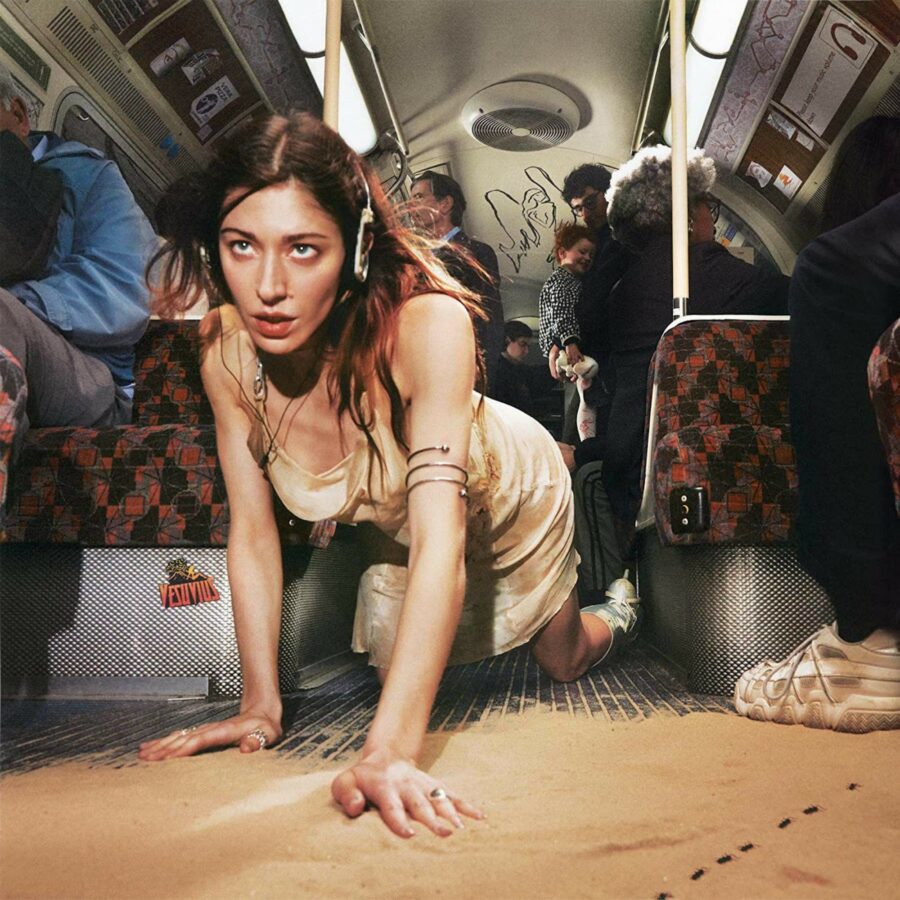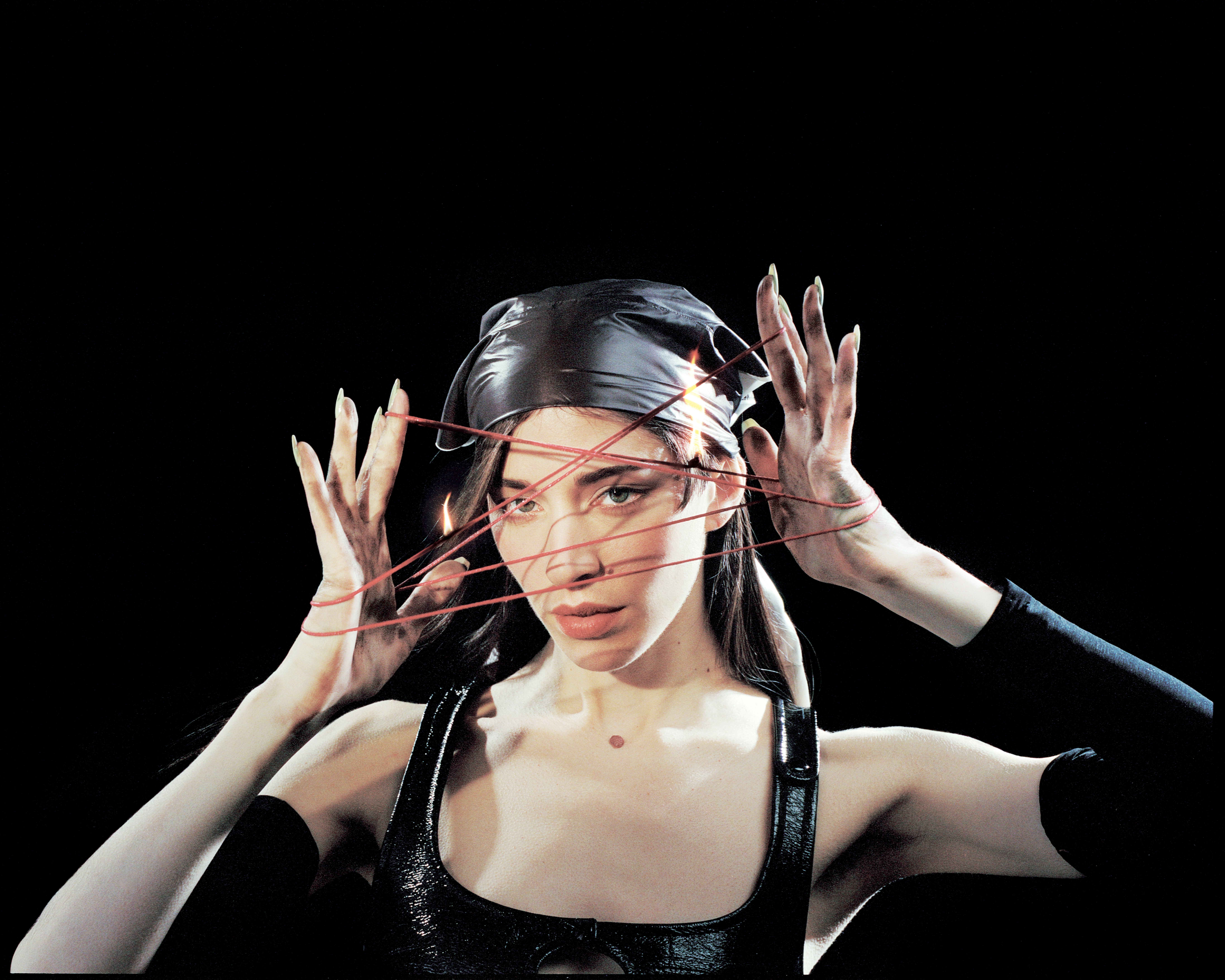Pop artist Caroline Polachek brings her addictive beats, synths and vocal acrobatics to Ryman Auditorium on May 17 on her American tour in support of our Record of the Week, her newest LP called Desire, I Want To Turn Into You. On a February day she was preparing to play in Paris, after some show cancellations due to winter illness, I snagged some time Zooming with a rested-up Polachek, one of modern music’s inarguable “It Girls,” to discuss her songwriting process and multiple interpretations of the album’s title.
After lapping up several ear-wormy singles in past months, I found the full 12 tracks comprising Desire… (released on Valentine’s Day) to be altogether sexy, soaring, and with clear homage to vocalists we both grew up pumping through Discmans. Polachek’s second solo record is both nostalgic and fresh, like her choice to enlist Dido and Grimes on the ballad “Fly To You,” with decades-spanning artists singing of long-distance longing over trap drums.
What’s clear over my many listens of Desire…, and talking with Polachek about her craft, is that she’s a fiercely creative, ambitious and focused composer who’s undaunted in her quest to juxtapose modern pop production tricks (booms, crashes, loops) with timeless, world-hopping instrumentation (flamenco guitar, a children’s choir and bagpipes, for crying out loud!). The results are outstanding.
On the Record: A Q&A With Caroline Polachek
Celia Gregory: Desire, I Want To Turn Into You is our Record of the Week. Can you start by telling me — because it feels like it’s open to interpretation — what this means, actually?
Caroline Polachek: Well, to me it has three meanings, but I’m sure to listeners they’re already developing their own. And actually that’s what I like about it, is how open it is, and every single interpretation is automatically quite profound. But to me it means three things: one being desire to turn into desire itself, to just become pure energy, velocity, feeling and not embodied. And I think that’s one thing. You know, one of the amazing things that music can do for us is we can kind of leave our bodies and just become. I think of pop songs, actually a lot of music in general, as like roller coasters and roller coaster design. I think that’s one of the beautiful things about melody is you can enter this other energetic dimension. So that’s kind of the most abstract version of the title.
And then “desire, I want to turn in to you,” I want to turn into the subject of my desire, the object of my desire, which is a kind of bizarre and grotesque and like totally self-defeating feeling that we have when we’re in love, right? Because if you turn into the person you’re in love with, you can’t enjoy them. But I do feel like there is this desire to fuse with someone, with their memories and with their passions and with their body. And maybe the only true way we get to do that is by having a child. And that child is the fusion. We never actually get to do it ourselves. So it’s this impossible desire.
And then the third way or the third thing the title means for me is just this very sweet physical thing of wanting to be held by someone. I want to turn into you. I think all three of those desires find different songs to play out in on the album.
CG: Beautiful. I hadn’t thought about the third way, and now I will think that during that chorus [of “Welcome To My Island”] — like turning from being the little spoon into somebody’s body.
CP: Just hold me.
CG: Ah, I’m unwell. OK, speaking of unwell, the visual imagery on this album. On your last solo record [2019’s Pang] you were climbing up on the cover, right? It’s like this heroine’s journey and now you’re fighting for your life in a subway car. Like, are you OK? What’s going on?

CP: We’re going down. You know, to me, the subway is such a special place. It’s where I have all my most intense music-listening experience. I’m a headphones listener. I moved to L.A. recently, which now makes me a car listener, but I really miss the experience in the subways because you’re surrounded by so many people, which I thought was important to include on the cover as well. This album really includes the idea of existing in the world. I hear the words “escapist” and “fantasy” thrown around a lot, but I really reject that. It’s about the real world and how beautiful and profound and strange being alive is. It’s not this other thing. It’s the real thing. And for me, being on the subway is emblematic of being in the real world.
But of course, it’s not a normal subway ride. It’s filling with sand. I’m on hands and knees, looking up past the camera to something that you can’t see. And we’re not sure. Am I desperate? Am I, like, pathetic? Am I a detective finding something? Do I sense an emergency that no one else senses? It’s full of questions. So that’s what the cover is trying to do.
CG: You sort of double-down on that where it feels like, in the “Welcome to my Island” video, you’re running for your life. But no, you’re liberating yourself. Then you’re deflecting sperm that’s orbiting around you!
CP: I don’t know, when I was doing that scene — which was shot in a quarry, an active quarry as well — I was manically chasing the camera. So it wasn’t so much about escaping anything as I’m manically and maybe creepily pursuing the camera.
CG: Creepily, though, you do that well. This is beautiful, glittery pop music, but it’s seductive. It’s a little bit scary. That seems intentional, right? I read some of the notes you had about, what, “scorny” — scary slash horny. What’s that about?
CP: If that’s not in the dictionary by next year, I’ve failed, honestly. So for listeners not familiar with my new addition to the English language, I invented the word “scorny” to describe the combination of horny and scary as a musical genre. I had started kind of jokingly putting together a playlist, which was of course very heavy on Nick Cave, Scott Walker. Even some Janet. I thought I should contribute my own song to the genre, which is why a song called “Crude Drawing of an Angel” was born. Scorny.
CG: You know what else you’ve added? My two favorite new compound words are “hopedrunk everasking.” That hit me like a ton of bricks, individually those words, but also together.
Let’s get into some of the specifics of the songs and musical choices. Is the baby noise on “Bunny Is A Rider” intentionally reverent to the Aaliyah song [“Are You That Somebody”]? I want to do a whole damn playlist of baby noises piped in. I didn’t realize you made that connection yourself. And then also there’s a nod to Toni Braxton in the song [“My heart is unbreaking”]. You’ve also admitted you’re in a Celine Dion phase. We’re probably around the same age and I hear a lot of late nineties, early aughts pop music all throughout. Can you talk about some of those influences on your artistry, especially being able to do exactly what you want as a solo artist?
CP: The funny thing is, I wasn’t even so much interested in referencing this moment in time of the late nineties, early 2000s, which of course was a very formative time for me as a music lover. I felt like archetypally there were these artists, you know, you mentioned Toni Braxton and Celine Dion, but also it was Sarah McLachlan, Whitney was still really active. There were these powerhouse vocalists who had this effect of like being very comforting and also making music that felt really meaty, like really substantial and very solid. And also very full of heart. Heart and solidity were things that I was thinking about constantly through making this album.
And I feel like that kind of music and that approach to music making has not exactly fallen by the wayside, but it’s not really part of the dialog right now where it’s like an arms race to kind of use the new sounds and layering and vocabulary and and keep up with the way streaming is evolving. You know, song length and song BPM, which is all really fun and very interesting, but I kind of wanted to fill that void myself that I felt I had come to exist a bit — of, you know, music that was just really, really full of heart and felt very solid and very comforting. And so a handful of songs, particularly songs like “Blood and Butter,” “I Believe,” “Fly To You,” were sort of my novice attempts at doing my version of that kind of music.
CG: Solid and with heart. That’s a nice contrast there, because hearts are soft, right? I’m so glad you mentioned “Blood and Butter.” That song, musically, is like a surprise at every turn. When we shared it internally, to add it to airplay, somebody said “I didn’t expect the bagpipes, but here we go!” And I’m like, “She made it sexy, it’s working!” And then there’s the choral swell at the end. Can you talk about some of the choices made in that song specifically, which I’ll most definitely feature for Record of the Week?
CP: Well, thank you so much for featuring it, I love that song so much. The tone choices and that one really all came from the melodies. That song started as an experiment between me and co-producer Daniel Hurrell to write a song with just two chords in it. And we really tried our hardest to keep it to two. But if you listen towards the end, we do cheat twice by inserting this minor sixth chord that comes in that just gives it this depth out of nowhere that you don’t really expect. And then we go back and then you get it one more time.
But the song has this sort of like windswept and kind of like tantric quality that to me again, wants this connection between folk instrumentation and deep techno palette. And I love finding these really interesting points of crossover where, you know, vocals start to feel like synths and bagpipe, for example, starts to feel like a voice. One of the the tools that I enjoy using as a vocalist is really hard changes between notes like [sings] — you know, like really hard flips between notes. And bagpipe is an instrument that also has that. So I have this very bodily response when I hear bagpipe, I can really feel it coming out of a body. It feels so vocal to me and also so connected to the way I sing. A lot of synthesizers are that way, as well, the way that they have note movement, texture. So that was a kind of point that I’d been wanting to make for a while in the song.
But I became quite obsessed with this Scottish bagpipe player named Brìghde Chaimbeul, who put out an incredible record called The Reeling, I believe, last year. And I was listening to it nonstop in the airplane on this summer tour was when I was like dead tired, staring out the window over green Spanish mountains, just wishing I was down there. And at the same time that song “Blood and Butter” had just been born. And it just felt like a magic combination. I was like, Wait a minute, this plus this equals magic.” So that was a bit of a lucky strike to find her at the exact right time.
CG: You came through with your band Chairlift and then you’ve been doing solo work on your own for the better part of ten years, but exclusively solo the last five or six. How would you describe your evolution, maybe as a songwriter, as a composer? You’re very technical in your approach, and yet it feels like it’s mellifluous, like the songs come out flowing. So how, how precise are you as a composer, and has that changed since you’ve been doing this fully solo?
CP: Well, my process with songwriting has ultimately never changed. I guess what I’m looking for in terms of mood obviously changes from song to song, but I always am starting with improvisation vocally, melodically. Melody always comes first for me and then, you know, sometimes it’s built on top of a preexisting chord progression or beat. I’m very rarely just singing out into space and building around that. I think of it as skiing, like I need to have some little moguls to ski around and some dynamics to jump, you know, like little waves to jump off of.
And then from there begins the painful and brutal process of lyrics. And I’m the slowest lyricist of all time, and it takes me forever, oftentimes, to even figure out what a song wants to say. And it always comes from the melody. And then I try to connect it back to something that’s actually happening in my real life. But it isn’t always. Sometimes it’s just tone poetry, and this album definitely jumps into that a bit. Like “Bunny Is A Rider” is just pure vibe. I’m splashing visuals around that aren’t trying to connect. There’s nothing to do with the plot. It’s just feeling and tone and fun and flavor.
And I really do believe that’s more of a universal language than storytelling, even. I believe in the creative process in the listener’s brain. When you’re given pieces that don’t connect, you paint the lines in yourself. And I think that leads to a more personal and often more psychedelic relationship with the music than it does if you’re just listening to a reading of something. So that’s a process I really enjoy of just kind of deciding how much of an image to fill in or not.
But yeah, then production is usually the sort of third step of dialing into the specifics of how things sound. And I get very in-depth on a mix, especially on this album. Some of these songs went through like 13 or 14 mix revisions before we actually got there. But I’m very lucky to be surrounded by amazing collaborators and everyone who’s passionate about detail and effects.
CG: I appreciate your humility as a songwriter, because as far as the lyrics, “dirty like it’s Earth Day” was like we’re done here. Mic drop. That’s my favorite shit, even just isolated. Like you said, it doesn’t have to make sense with the rest, baby voice and all.
How do you think about, or do you, when you’re writing songs, how the final production will need to be translated live, whether it’s the vocal acrobatics required of you or the number of instruments and beats and things that have to come through in a live setting? How are you thinking about that when you’re first in the creation stage?
CP: What people call production is really just music, right? It’s chords, it’s sounds, and that’s what we just reinterpret for the stage. I’m so lucky to have three incredible band mates and two more even off stage who are just running computer stuff, running audio. I really do consider my amazing sound guy part of the band. All of us have such a strong sense of the dynamic waves of every part of the song, and it’s always a game to see how much we can pull away from the album version so that people’s ears can be drawn just to the most important parts in the live show. Like a lot of the kind of ambient stuff on the album isn’t really necessary on stage. I think it’s really fun to see people hitting things and see people singing. So I try to bring things always back to that very caveman idea of music for the live show. Yes, there is pleasure in watching human beings hit things and sing. So it just comes back to that.
CG: Percussion? Bang a gong, get it on.
CP: Guitar, too. Let’s go.
CG: And that comes back to, like, there’s some seductive, a little bit violent imagery, too, through this. You say [in “Welcome To My Island”], “Hope you like me. You ain’t leaving.” Like, that’s possession. It’s a little sinister. And then also you have this church organ on one song but also [in “I Believe”], “Violent love, feel my embrace…Look over the edge, but not too far.” I just think there’s this tension and you really pull it off throughout the whole record.
CP: I mean, I guess what I’m trying to get through here is that life is not a rehearsal. The stakes are very high. So it’s not so much that I am trying to channel violence, per se, but just that that is what’s at stake in being here.

